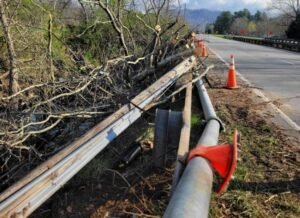It’s a late and nasty blow: Helene breaks Maggie Valley sewer line

A mangled mass of limbs can be seen on the upstream side of the Jonathan Creek bridge across U.S. 276, where winds and rain this weekend topped trees onto Maggie Valley’s sewer line. The pipe in the foreground is a run-around, channeling wastewater around the break and back to the main system.
Months after she stormed through Haywood County, Hurricane Helene had another surprise for Maggie Valley. After she had undermined the bank of Jonathan Creek at this U.S. 276 bridge, winds and rain this weekend topped the trees above it, breaking a sewer line.
Six months after she stormed through, Helene has wreaked her destructive power on Maggie Valley yet again, this time in the form of a broken main sewer line and resulting raw sewage spill into Jonathan Creek.
Helene apparently left behind a delayed-action device when her flood waters undermined the bank of Jonathan Creek where it flows under U.S. 276 about a mile from Interstate 40’s exit 20. All it took was the heavy rainfall over the weekend — and the sudden arrival of strong winds early Sunday morning — to topple several massive trees into the creek and the bridge itself.
When those trees fell, they broke apart the sewer line that carries wastewater from Maggie Valley and the hundreds of customers in the Jonathan Creek community, spilling it into the creek.
There is a fragment of good news in this latest round with Helene. The break and spill occurred in the early morning hours when water usage is still pretty low, said Maggie Valley Public Works Director Mike Mehaffey. The line would have dumped much more waste had it occurred later in the day.
Mehaffey did not know exactly how long the line spilled its load before discovery. However, if the winds that blew through Haywood about 6 a.m. Sunday were what pushed the trees over, it wasn’t long before it was reported, as the call came from the Jonathan Creek Fire Department about 6:15 a.m., he said.
Mehaffey immediately called on the neighboring Buncombe County’s Metropolitan Sewage District, which has a team prepared to respond to spill emergencies.
That team responded and installed a bypass pump and pipe to carry the sewage flow over the bridge before it was spliced back into the main line. That work was completed about 11:30 a.m., he said. And while it seems like a long time for a sewage spill, “flows are low early in the morning, and it takes about four or five hours for that morning flow to get to the treatment plant,” he added.
Mehaffey and engineers are still trying to assess the spill for the required reports to the N.C. Department of Environmental Quality’s Division of Water Resources.
“Once we get all the parties together and get all the reports to DEQ, we’ll be passing that along (to the public),” he said.
In the long term, Mehaffey said he expects the repair to the line to be far from simple, particularly given the location.
“We’ll know more about time frame and cost when we get the engineers to look at it closer than we could today,” he said Monday.
The volume of water in the creek from Sunday’s rains, and the heavy canopy of the fallen trees, were hindrances to an early assessment.
